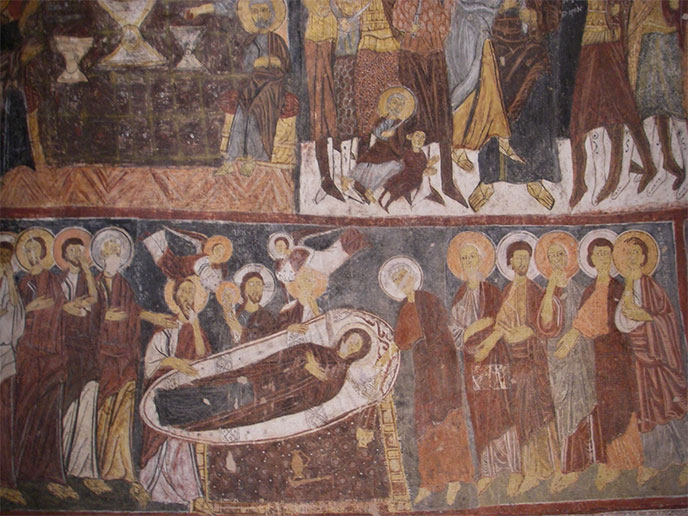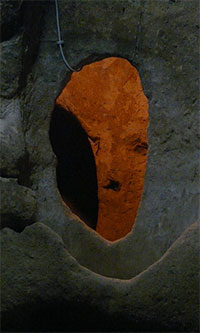
Cappadocia is hollow earth: twenty underground levels arranged on square kilometers. Miles of tunnels, acres of rooms and stairs, thousands of workers, millions of hours of work. When? By whom? Why?
Who could have dug this huge underground country, and for what purpose? Where do these cities come from, all connected together by tunnels, providing comfort like water pipes, toilets, light shafts?
Turkey, Cappadocia, near Nevsehir, around -4000: “The first inhabitants of Anatolia, the Hittites, have dug houses in the soft rock of the cliffs in order to protect from the elements and to take refuge there in case of attack. Later, in the seventh century, the inhabitants have built entirely underground cities to escape the invasions of Persians and Arabs. There would be a hundred cave-dwelling villages in the rocky peaks of Cappadocia. You can only visit the underground cities of Nevsehir, Özhonak, Mazi, Kaymakli or Derinkuyu. The underground city of Kaymakli is the most visited in this region. It stretches over several miles and has eight levels.
The people could live independently for several months without betraying their presence. Nearby, the underground city of Derinkuyu is the largest one: it could accommodate more than 30,000 people on no fewer than 18 levels. Only the first eight have been explored.” (source)Brochure Cappadocia, Ministry of Tourism of Turkey, Ankara, 1998
There is good reason for this: the lower levels are flooded with sediment that make them virtually impassable. By themselves, these alluvial deposits show that the cities are prior to the Würm thaw, obvious cause of the great flood as evidenced by so many myths around the world.
The great city of Derinkuyu is certainly “the most interesting among the underground cities. It had a 60 yards deep well for the water supply, essential during a lasting siege. A tunnel about seven miles long connected Derinkuyu to Kaymakli.” (source)Brochure Cappadocia, Ministry of Tourism of Turkey, Ankara, 1998
How did these mysterious troglodytic people live? Pretty good indeed. The underground cities, built or rather dug over several levels, included stables, warehouses, cellars, dormitories, churches and common rooms. Hallways and stairs allowed people to move from a dwelling to another. There was a ventilation system with large fireplaces and a system of inlet and draining of water! This great control over water as evidenced by the apparent profusion of underground pipes make the cities of Cappodocia resemble the other hydraulic civilizations, which are the oldest known.
Let’s quote that of the Indus Valley in India, that of Tiahuanaco in the Andes, that of Teotihuacan in Mesoamerica: they are all hydraulic civilizations. Considering all the underground cities of Cappadocia, a total population of two hundred thousand inhabitants would have lived in.
It was a buried country , all cities were connected. A major archaeological discovery has still to be done: the complete exploration and the statement of this vast underground network. Cappadocia would be a real Swiss cheese.
The official version claims that these underground cities were dug by the Hittites from -4000. But why would they have dug all those mountains, without an urgent reason?
“To protect from the elements” is the official answer. What elements? In -4000, the ice age of Würm was finished ages ago. Even worse: from -9000, the thaw has caused countless floods.
These floods are completely incompatible with an underground habitat: the inhabitants would have been drowned for sure. The rest of the official version, much less realistic, says that troglodytic works and underground levels have been enlarged and extended by the Christians, forced to live hidden to protect from the Islamic upsurge of 642.

It is true that there are Christian murals and chapels, but they are all located at higher levels, next to or above the surface, which shows little desire to hide. “Something is not right, notes Andrew Collins. The normal reaction of a community fearful of being crushed by an armed invader would be to reach safer areas, what made many Christians who established in Eastern Europe, especially in Greece. It was crazy to dig a hole in the ground and hide there in the hope that the persecutors would eventually leave.”
Especially since, as we said, instead of burying themselves deep like moles, Christians have only occupied the surface levels.
Ignorance is not the lack of knowledge, but the lack of self knowledge ; without self knowledge there is no intelligence. (Jiddu Krishnamurti)
And why the lower we go, the higher the ceilings of tunnels are? And when were built these mysterious troglodytes? These questions will raise many more others …
The official version claims that these underground cities were carved by the Hittites from 4000 BCE. For what obscure reason did they worked so hard
Once again, the official version is lacking of seriousness and conscience. Against what cataclysm could have been dug all these burrows? The Cities of the Peaks protected Andeans against the ravages of raging waters. But the underground cities would have not protect against floods, inhabitants would have been drowned like rats in a hole. On the contrary, they could have promoted the survival during the last ice age. The underground structures are little sensitive to surface temperature.
From the third underground level, it reigns a constant temperature of 11°C, which can easily resist the surface frost.
As the one who prevailed in this part of the world during the last Ice Age for example… According to Omer Demir who serves as curator of these cities, the building may date from before the last Ice Age, ie more than 100,000 years ago.
After the myth of Ice Age Noah, here is another clue of the presence of developed men in a very distant past. Because these galleries had to be dug before the surface frost renders the rock too hard, so before the beginning of Würm 110,000 years ago! It had to be that a “god” alerted the first men to take shelter in this place. And so that a “god” be there to guide them, it had to be that a civilization had time to develop, say several thousand years before the flood, what brings us closer to -150,000. Yet that date is that of the official appearance of modern man.
You are wrong, gentlemen Paleo-Anthropologists, you narrow-minded disciples of imprudent Darwin, man was a god at that time and has never been an ape’s cousin!
Man our true ancestor was a giant god descended from heaven to land atop Nemrud Dag in Turkey. He called Ahura Mazda, heavenly light. He is the founder of our current species , its science and civilization. He has many names, he visited this planet in many times and many places. We are all sons of astronaut gods.
Beside the official version of paleoants – i.e. anthropologists: they deserve this mockery – here’s what the Persian tradition told.
 The god of gods Ahura Mazda came to Yima , who was a righteous, wise and good man.
The god of gods Ahura Mazda came to Yima , who was a righteous, wise and good man.
“A terrible winter will befall the earth, a winter that will last for generations. All humans will die except those who will be housed in the soft belly of the earth, where a constant temperature prevails. Yima, said Ahura Mazda, take thousand workers to hollow earth and rock, to dig an underground city and plan to bring down there all useful animals and plants.”
Yima did what God had asked and the survivors have spent a hundred thousand years that Ice Age did last in an underground comfort they have had every opportunity to improve over the centuries and millennia. This story seems credible, at least it awakens in us profound echoes, painful, genetic memory of one hundred thousand years waiting for the sunshine.
Let the sunshine in …
During this long period of life that was developed underground electrical Vril energy, he had to overcome the lack of sunlight for plants, animals and people. For the same reasons of survival against the ice age , it is possible that this underground network was present elsewhere in Cappadocia.
![H. Hahn et Héléna Blavatsky - Domaine Public - By По одной из версий автором картины является Е. П. Блаватская [Public domain], via Wikimedia Commons - recadré par SK pour Eden Saga H.Hahn_and_H.Blavatsky-200po](https://eden-saga.com/wp-content/uploads/H.Hahn_and_H.Blavatsky-200po.jpg) Myths evoke tunnels under Americas , the world beneath the earth of the god Enki, the god of the underworld Hades, or the underworld kingdom of Agartha .
Myths evoke tunnels under Americas , the world beneath the earth of the god Enki, the god of the underworld Hades, or the underworld kingdom of Agartha .
Following Helena Blavatsky , Edgar Jacobs evokes Atlantis that have survived to this day in a vast underwater empire. This hypothesis can smile, until we remember that at the bottom of lakes in Siberia, divers met the Red Army invincible giants. Yes, men of very large size , as the deepest galleries of Cappadocia, which can not be visited. The lower levels get much higher ceilings and tunnels are carved on a very regular basis, probably with a TBM.
The rock surface is vitrified, suggesting a laser cutting. We are dealing here with a technological world, having scientifically prepared a long-term survival in a hostile environment.


